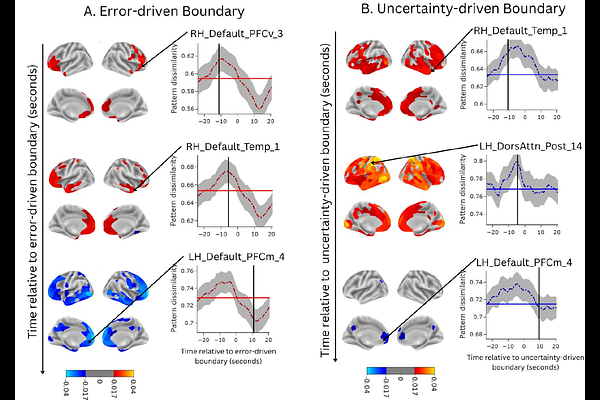Multiple event segmentation mechanisms in the human brain

Multiple event segmentation mechanisms in the human brain
Nguyen, T. T.; Etzel, J. A.; Bezdek, M. A.; Zacks, J.
AbstractThe human brain segments continuous experience into discrete events, with theoretical accounts proposing two distinct mechanisms: creating boundaries at points of high prediction error (mismatch between expected and observed information) or high prediction uncertainty (reduced precision in predictions). Using fMRI and computational modeling, we investigated the neural correlates of error-driven and uncertainty-driven boundaries. We developed computational models that generate boundaries based on prediction error or prediction uncertainty, and examined how both types of boundaries, and human-identified boundaries, related to fMRI pattern shifts and evoked responses. Multivariate analysis revealed a specific temporal sequence of neural pattern changes around human boundaries: early pattern shifts in anterior temporal regions (-11.9s), followed by shifts in parietal areas (-4.5s), and subsequent whole-brain pattern stabilization (+11.8s). The core of this dynamic response was associated with both error-driven and uncertainty-driven boundaries. Critically, both error- and uncertainty-driven boundaries were associated with unique pattern shifts. Error-driven boundaries were associated with early pattern shifts in ventrolateral prefrontal areas, followed by pattern stabilization in prefrontal and temporal areas. Uncertainty-driven boundaries were linked to shifts in parietal regions within the dorsal attention network, with minimal subsequent stabilization. In addition, within the core regions responsive to both types of boundaries, the timing differed significantly. These findings provide evidence for two overlapping brain networks that maintain and update representations of the environment, controlled by two distinct prediction quality signals: prediction error and prediction uncertainty.